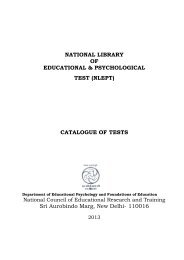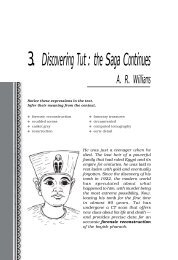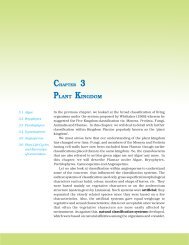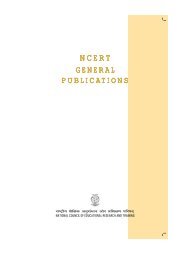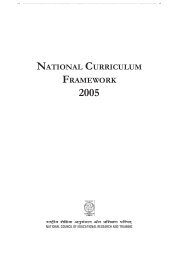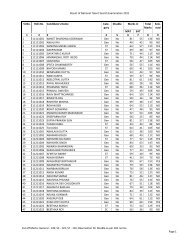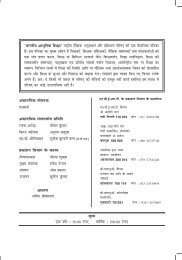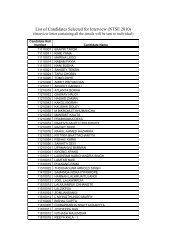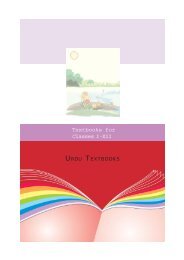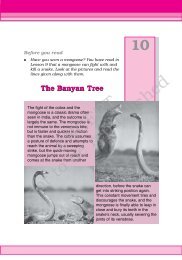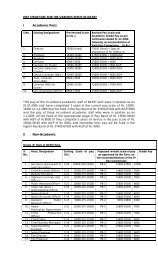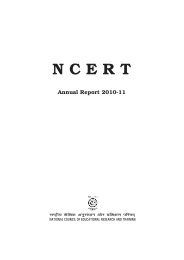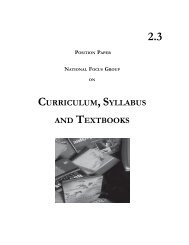indian education - National Council Of Educational Research And ...
indian education - National Council Of Educational Research And ...
indian education - National Council Of Educational Research And ...
Create successful ePaper yourself
Turn your PDF publications into a flip-book with our unique Google optimized e-Paper software.
Religion, Education and Peace 35<br />
enlisted Rishi Valley into the elitist body<br />
in the Fifties. Yet, from the very beginning<br />
the Rishi Valley landscape lacked some<br />
fundamental qualifications of Indian<br />
residential public schools. It is not<br />
located in the temperate zone, in hill<br />
stations made fashionable during the<br />
colonial period. Though standing at an<br />
altitude of 2500 feet, it was an area in<br />
Rayalseema, where drought turned the<br />
surroundings brown, the bald granite<br />
rocks radiated the sun’s heat, and<br />
villagers walked with their cows through<br />
the school campus. India’s colonial past<br />
was nowhere present in the landscape<br />
Krishnamurti chose. <strong>And</strong> yet the<br />
students who attended his school were<br />
products of several generations that had<br />
benefited from the colonial presence.<br />
The consequences of educating<br />
students in an ivory tower oblivious to<br />
the world’s suffering remained with<br />
Krishnamurti as the school’s population<br />
in due course increased to roughly five<br />
hundred inhabitants, students born and<br />
bred in the urban centres of India and<br />
well-educated teachers from some of the<br />
best institutions in the country.<br />
Krishnamurti’s talks to students were<br />
filled with sharp portraits of village life<br />
meant to challenge students. ‘Have you<br />
ever’, he asked them, ‘observed the poor<br />
people, the peasants, the villagers, and<br />
done something kind—done it<br />
spontaneously, naturally, out of your<br />
own heart, without waiting to be told<br />
what to do?’ (LA, p. 29).<br />
If we were to educate students<br />
without regard to the poverty in the<br />
Valley we were in danger of falling under<br />
the category of omnivores, as defined by<br />
the ecological historians Madhav Gadgil<br />
and Ramachandra Guha (Gadgil and<br />
Guha, 1995). The classification of India’s<br />
population into omnivores, ecological<br />
systems people and ecological refugees<br />
is based on the comparative<br />
consumption patterns and access to<br />
resources of the urban and rural elite<br />
and the urban and rural poor. Nearly four<br />
fifths of the population of India are poor,<br />
either ecological people, dependent on<br />
nature’s dwindling resources or<br />
ecological refugees forced out of their own<br />
locality by the encroaching industrial<br />
civilisation. The majority of our fee-paying<br />
students and some of our teachers and<br />
administrators belonged to Gadgil and<br />
Guha’s first category of omnivores.<br />
The results of the urban-rural divide<br />
are best described in a recently published<br />
work by Guha —<br />
India is in many ways an economic<br />
disaster zone; marked by high rate of<br />
deforestation, species loss, land<br />
degradation, and air and water pollution.<br />
The consequences of this abuse have<br />
been chiefly borne by the poor in the<br />
countryside – peasants, tribals,<br />
fisherfolk, and pastoralists who have<br />
seen their resources snatched away or<br />
depleted by powerful economic interests<br />
(Guha, 2006, p. 232).<br />
Narpat Jodha’s research in several<br />
dryland districts of the country adds<br />
another frame of reference to our view of<br />
surrounding village life. On the basis of<br />
comparative study of villages with vital<br />
common property holdings, he concludes<br />
that these shared resources support<br />
between 15-25 per cent of income of the<br />
poorer farmers and shepherds in dry<br />
region. He makes out a strong case for<br />
governments to replenish Common<br />
Property Resources in the countryside,<br />
as they provide both food security and



